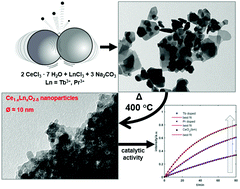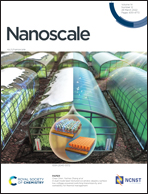Defect-controlled halogenating properties of lanthanide-doped ceria nanozymes†
Abstract
Marine organisms combat bacterial colonization by biohalogenation of signaling compounds that interfere with bacterial communication. These reactions are catalyzed by haloperoxidase enzymes, whose activity can be emulated by nanoceria using milli- and micromolar concentrations of Br− and H2O2. We show that the haloperoxidase-like activity of nanoceria can greatly be enhanced by Ln substitution in Ce1−xLnxO2−x/2. Non-agglomerated nanosized Ce1−xLnxO2−x/2 (Ln = Pr, Tb, particle size < 10 nm) was prepared mechanochemically from CeCl3 and Na2CO3 followed by short calcination. Lanthanide metals could be incorporated into the CeO2 host without solubility limit, as shown for Tb. The distribution of the Ln3+ defect sites in the CeO2 host structure was analyzed by electron spin resonance spectroscopy. Ce3+ and superoxide O2− species are present at surface sites. Their formation is promoted by increasing dopant concentration. Ce1−xLnxO2−x/2 was prepared in copious amounts by ball-milling. This energy-saving and residue-free method can be upscaled to industrial scale. The surface defect chemistry of Ce1−xLnxO2−x/2 was unravelled by vibrational spectroscopy. It is associated with the mechanochemical preparation and leads to enhanced catalytic activity. Although Ce0.9Pr0.1O1.95 had a lower BET surface area than pure CeO2, its catalytic activity, calibrated by oxidative bromination of phenol red, was much higher because the ζ-potential increased from 15 mV (for CeO2) to 30 mV (for Ce0.9Pr0.1O1.95). This facilitates adsorption of Br− in aqueous conditions and explains the high catalytic activity of the Ln-substituted CeO2. Ce1−xLnxO2−x/2 is an effective and “green” nanoparticle haloperoxidase mimic for antifouling applications, as no chemicals other than the ubiquitous Br− and H2O2 (generated in daylight) are required, and only natural metabolites are released into the environment.



 Please wait while we load your content...
Please wait while we load your content...